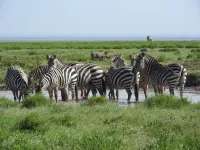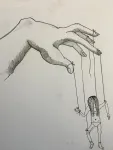Water is a probable vector for mammalian virus transmission
2021-02-16
(Press-News.org) Water is a necessity for all life but its availability can be limited. In geographical areas experiencing dry seasons, animals congregate near the few freshwater sources, often reaching large densities. At these sites many animals from different species come to the same spots to drink, potentially operating as key locations for pathogen transmission within and between species. An international team of scientists lead by the German Leibniz Institute for Zoo and Wildlife Research (Leibniz-IZW) suggests that viruses can use restricted freshwater sources as a vector to be spread among animals. The key prediction of this idea is that animal viruses remain stable and infectious in water. The team tested this idea by sampling water holes in ecosystems of Africa and Mongolia with pronounced dry seasons and growing viruses in such water. The scientific results demonstrated that this was indeed possible and are published in Science of the Total Environment.
The distribution of freshwater varies geographically and seasonally, with places such as East Africa and Central Asia experiencing pronounced seasonal shortages. Water scarcity results in frequent, unstable congregations of numerous wildlife species in the vicinity of freshwater sources. The objective of the scientific research work was to determine whether viral stability in restricted water sources is sufficient for some mammalian viruses, thereby enabling their spread through the medium of water.
Equine herpesviruses (EHV) were selected as a model as they are known to remain stable and infectious in water for weeks under laboratory conditions and circulate in wildlife in both Africa and Mongolia. "We knew from our previous work, particularly with zebras in Africa, that equids become stressed when they are forced to aggregate in the dry season. When we looked at the effects of stress in captive zebras, we could see that it was associated with shedding of EHVs into the environment. This suggested that just at the time when animals are forced to congregate, they are most likely to be stressed and shed viruses. The stress is acting as a sort of signal to the virus to get into the water to infect more individuals," says Prof Alex Greenwood, the leader of this scientific work.
"Congregations also help explain some odd results from both captive and free-living wildlife, such as the infection of non-equids with EHVs, for example, rhinos," explains Dr Peter Seeber from the Leibniz-IZW who collected water and zebra samples in East Africa. "If rhinos share the water with equids, they are likely exposed to the virus," adds Dr Sanatana Soilemetzidou form the Leibnz-IZW, who collected the water and animal samples in Mongolia.
To be validated, the entire concept of water as a viral vector hinged on showing that EHV remain stable in environmental water. "We were unsure what to expect given that culturing viruses from the environment is challenging given all the other microbes that can grow when you try to isolate a virus," comments Dr Anisha Dayaram, the lead author from the Leibniz-IZW. Dayaram and her colleagues succeeded in doing exactly that, using the water samples collected from both Africa and Mongolia. Under cell culture conditions they demonstrated that EHVs could indeed replicate and remained infectious.
This seems to explain the rather odd result that EHVs seem to show limited viral evolution. Viruses tend to evolve rapidly but EHVs change little over time and are in this sense surprisingly stable. The EHVs found in Mongolia and Africa are nearly identical to those in domestic horses. This may represent a constraint or equilibrium state for the EHV found in water holes. "Our results suggest that the stability of EHV in water may be the result of a long evolutionary process, which has led such viruses to be truly adapted to using water as a vector," explains Dr Alexandre Courtiol, another Leibniz-IZW scientist involved in this scientific work.
EHVs are not the only viruses that can be shed into and spread through water. Further research should uncover whether other viruses may use water in a similar way as vector to spread among animals. The work also suggests that understanding viral dynamics will require looking beyond virus host interactions in some cases and should include adaptations to transmission via the environment.
INFORMATION:
[Attachments] See images for this press release:

ELSE PRESS RELEASES FROM THIS DATE:
2021-02-16
The effects of microplastics on our health and the environment are being rigorously studied all across the world. Researchers are identifying microplastic sources and their potential routes to the environment by examining rainwater, wastewater, and soil.
Microplastics have been found in nearly all organisms and habitats everywhere in the world. However, factors contributing to the influx and accumulation of microplastics in water ecosystems aren't fully understood yet. The focus of microplastics research has, for a long time, been on the age of microplastics found in sediments, and on the ...
2021-02-16
The researchers analysed cells, mouse models, and human patient samples using biochemical, mathematical, and biophysical methods. They identified a protein present in the mesh-like membrane structure (the basement membrane) associated with tumour and vessel softness, and good survival of cancer patients. The researchers tested if removing this protein from the basement membrane would enhance the spread of cancer, which it did, and if supply of this protein would reduce cancer spread, which it did. They proceeded to show that the levels of this protein (netrin-4) already present in basement membrane of organs may determine cancer spread even before cancer develops, ...
2021-02-16
Cells of organisms are organized in subcellular compartments that consist of many individual molecules. How these single proteins are organized on the molecular level remains unclear, because suitable analytical methods are still missing. Researchers at the University of Münster together with colleagues from the Max Planck Institute of Biochemistry (Munich, Germany) have established a new technique that enables quantifying molecular densities and nanoscale organizations of individual proteins inside cells. The first application of this approach reveals a complex of three adhesion proteins that appears to be crucial for the ability of cells to adhere to the surrounding tissue. The research results have been published in the journal Nature ...
2021-02-16
Using an advanced technique, scientists from the RIKEN Cluster for Pioneering Research have demonstrated that a chemical reaction powered by light takes place ten thousand times faster at the air-water interface--what we usually call the water surface--than in the bulk of the water, even when the light has equivalent energy. This finding could help our understanding of the many important chemical and biological processes that take place at the water surface.
Water is the most important liquid in nature, and research has shown that there is in fact something special about the interface. For reasons that were not well understood, it appears that some chemical reactions take place readily when the molecules are partly in the water, but not when they are fully ...
2021-02-16
The risk of both mortality and rehospitalisation after an elective revascularisation procedure for coronary artery disease is similar for people with and without Alzheimer's disease (AD), but people with AD had worse outcomes after an emergency procedure, according to a new study from the University of Eastern Finland.
Previous studies have investigated the effectiveness of revascularisation in persons with cognitive disorders, but only in terms of short-term outcomes and in acute care settings, and they also have not accounted for electivity. Similar to previous ...
2021-02-16
New analysis published in The Lancet Psychiatry has shown a lack of strong evidence to support current guidance on psychological therapies for treating anorexia nervosa over expert treatment as usual.
The findings highlight a need for further research and support a call for individual trial data to be made available so the benefits of treatments in specific patient populations can be better understood.
Conducted by an international team of clinical experts and researchers, the analysis included 13 randomised controlled trials and a total of 1049 patients. The studies compared psychological therapies to treatment as usual in adults receiving outpatient treatment for anorexia. The trials measured eating disorder ...
2021-02-16
Drilling a 270,000-year old core from a Tasmanian lake has provided the first Australian record of a major global event where the Earth's magnetic field 'switched '- and the opportunity to establish a precedent for developing new paleomagnetic dating tools for Australian archaeology and paleosciences.
"This is the first study of this kind in Australia since pioneering studies in the 1980s," said author Dr Agathe Lisé-Provonost, a McKenzie Fellow from the School of Earth Sciences at the University of Melbourne.
"Just two lakes in north-east Australia previously provided such "full-vector" record, where both the past directions and the past intensity of the Earth magnetic field are obtained from the same cores."
Published in the journal Quaternary Geochronology, Chronostratigraphy ...
2021-02-16
Milan, 15 February 2021 - Excitons are quasiparticles which can transport energy through solid substances. This makes them important for the development of future materials and devices - but more research is needed to understand their fundamental behaviour and how to manipulate it. Researchers at Politecnico di Milano in collaboration with the Institute of Photonics and Nanotechnologies IFN-CNR and a theory group from the Tsukuba University (Japan) and the Max Plank Institute for the Structure and Dynamics of matter (Hamburg, Germany), have discovered that an exciton can simultaneously adopt two radically different characters when it isstimulated ...
2021-02-16
The researchers of TPU together with their colleagues from Russian and foreign scientific centers have found a way to estimate the temperature of a chemical reaction activated by pseudo-particles - plasmons. Two organic molecules served as ultra-small sensors or thermometers. According to scientists, the experiments are of great fundamental importance: beyond the mere fact of evaluating the temperature with the use of molecules, it was possible to demonstrate that properties of plasmon serving as an activator of chemical reactions depend not only on thermal ...
2021-02-16
Certain plasma microRNAs could serve as diagnostic biomarkers in mild traumatic brain injury, a new study from the University of Eastern Finland shows. The biomarkers were discovered in an animal model and they were successfully used also to diagnose mild traumatic brain injury in a subgroup of patients. The study was published in the International Journal of Molecular Sciences.
Mild traumatic brain injury is difficult to detect by contemporary conventional imaging methods. In fact, most patients do not exhibit visible structural damage to the brain, which could ...
LAST 30 PRESS RELEASES:
[Press-News.org] Water is a probable vector for mammalian virus transmission





